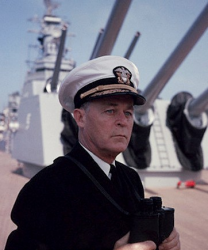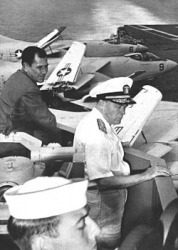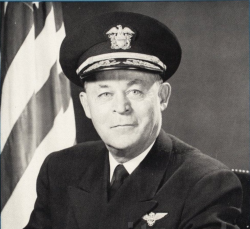
 |
|
|
||
|
Charles Randall Brown 'Cat' |
||||
|
Graduate, U.S. Naval Academy, Class of 1921 Engagements: • World War I (1914 - 1918)• World War II (1941 - 1945) |
||||
| Biography: | ||||
|
Charles Randall "Cat" Brown Admiral, U.S. Navy Charles Randall Brown was born on 13 December 1899 in Tuscaloosa, AL. Brown received an appointment to the U.S. Naval Academy. He proved to be an unruly plebe at Annapolis; he logged 300 demerits and squeezed out near the bottom of his Class of 1921. He was designated a Naval Aviator in 1924. The exuberant Brown spirit chafed at a rash of peacetime desk jobs and boiled over in 1943 [he was then a Captain]. "I've got a carrier [the USS Kalinin Bay], and I'd like a job of work," he told Admiral Raymond A. Spruance. Spruance snapped: "You've got one." For two years the Kalinin Bay escort carrier steamed through the thick of the action: in the Marianas, the China Sea, and the Battle of Leyte Gulf. In addition to the Kalinin Bay, Brown was also Captain of the aircraft carrier USS Hornet in the Pacific during World War II. In 1952, he was named Commander of Carrier Division 6 in the Mediterranean Sea. Brown, now a Vice Admiral, was named Commander of the U.S. Sixth Fleet under Admiral James L. Holloway, Jr. in 1956. In July 1956, the Suez Crisis began. On 29 October Israeli forces began attacks in Egypt. And on the following day, Britain and France stepped in as "peace keepers." The "Naval Institute Historical Atlas of the U. S. Navy" reports that on 30 October the Chief of Naval Operations (CNO), Admiral Arleigh Burke, signaled Vice Admiral Charles R. "Cat" Brown, the Commander of the Sixth Fleet (COMSIXTHFLT): "Situation tense; prepare for imminent hostilities." Brown signaled back: "Am prepared for imminent hostilities, but whose side are we on?" In classic Burke style, the CNO's return response was, "Keep clear of foreign op areas but take no guff from anybody." The following excerpt appeared in the Monday, 28 July 1958 issue of Time magazine: "Vice Admiral Charles Randall Brown, 58, is commander of the Mediterranean-based Sixth Fleet. To Alabaman "Cat" Brown, bossing this 418,000-ton, 76-ship armada is "the best job in the whole Navy." Forty years in the Navy have rubbed the undisciplined edges off Scripture-quoting Cat Brown, but they have not blunted his claws. While he is perhaps the U.S.'s smoothest and most widely known diplomat in Mediterranean countries, he keeps the Sixth Fleet ready and able to serve as a massive instrument that can deliver atomic destruction-or the threat of it-anywhere, even to Moscow. " On 1 January 1959, Brown was promoted to the four-star rank of Admiral and assigned as the Commander-in-Chief, Allied Forces Southern Europe (CINCSOUTH). He remained in that command until the end of 1961. Admiral Brown retired from the Navy in January 1962. The Gray Eagle Award In 1959, while serving as Commander-in-Chief, Allied Forces, Southern Europe, Admiral Charles R. Brown, USN, wrote to the Deputy Chief of Naval Operations (Air), Vice Admiral Robert B. Pirie, USN, telling of certain discussions he had with Vice Admiral George W. Anderson, then serving as Commander, Sixth Fleet. "We suggest that it be determined from official records who, at all times, is the senior aviator in point of service in flying; that a baton or similar token be awarded him, and that, with due ceremony, this symbol be handed on down to the next man with the passing years." Admiral Pirie took the matter from there. For a time the title "Bull Naval Aviator" was a leading contender for the choice of names for the senior aviator's title. Various cups, statuettes, plaques and medals were proposed. Finally, a competition was conducted between aircraft companies desiring to sponsor the award. The design from the Chance Vought Aircraft Company (later LTV Corporation, Ling-Temco-Vought) was selected, and the Gray Eagle Award was brought into reality. The Gray Eagle Award is presented to the Naval Aviator on continuous active duty in U.S. Navy or Marine Corps who has held that designation for the longest period of time. The Gray Eagle Trophy made its first appearance in 1961 during the Navy's celebration of the Fiftieth Anniversary of Naval Aviation. The First Ceremony On 5 January 1961, at Naval Aviation's Fiftieth Anniversary Ball, held at the Sheraton Park Hotel, Washington, DC, Admiral Charles R. Brown received the Gray Eagle Trophy from Admiral James S. Russell, then serving as Vice Chief of Naval Operations. While Admiral Brown was the first "active" aviator to receive the Trophy, replicas of the award were presented to all previous holders of the distinction, or their representative, during the ceremony. The recipients included Mrs. T. G. Ellyson, widow of Naval Aviator Number One, Commander Theodore G. Ellyson. Commander Ellyson would have held the Gray Eagle title from 1911 to 1928, if the award had been in existence. The Trophy The Trophy, donated by Ling-Temco-Vought, depicts a silver eagle landing into the arresting gear of the Navy's first aircraft carrier, USS Langley (CV-1). The inscription reads: "The Venerable Order of the Gray Eagle. The Most Ancient Naval Aviator on Active Duty. In recognition of a clear eye, a stout heart, a steady hand, and a daring defiance of gravity and the law of averages." Names of those who have held the title, either actively or prior to the 1961 ceremony, are inscribed on the trophy's plaque. The Gray Eagle Trophy may be kept in possession of and displayed by the command to which the Gray Eagle is assigned. Otherwise, it may be placed in the custody of the National Museum of Naval Aviation on a temporary basis until required for presentation to the successor. The ceremony date for the presentation of the Gray Eagle Award and the retirement date are not always the same. The award is passed down from the previous holder of the award on his or her retirement, or in case of death. A miniature replica is presented to each incumbent as a personal memento. Navy Distinguished Service MedalAwarded for actions during the Cold War The President of the United States of America takes pleasure in presenting the Navy Distinguished Service Medal to Admiral Charles Randall Brown (NSN: 0-19058), United States Navy, for exceptionally meritorious and distinguished service in a position of great responsibility to the Government of the United States while serving as Commander, American Naval Forces, Specified Command, Middle East, from 14 July to 23 October 1958. The complex and unpredictable politico-military situation prevailing in Lebanon during the United States operations there, and the organizational problems involved, presented Admiral Brown a task lacking in precedent, significant in scope, and historically important to world order and the independence of small nations everywhere. His dynamic leadership, professional skill, exceptional judgment, and high devotion to duty were responsible, in large measure, for the success of the operation. He acted with skill, perception, and promptness. His comprehension of the overall mission, the existing unstable Lebanon political conditions, and the potential of his own forces within this framework was exceptionally acute and sound. The speed, determination, precision, and thoroughness with which he deployed his forces from all parts of the Mediterranean are attested by the fact that the first landing of U.S. Marines was accomplished on the afternoon of 15 July, less than 24 hours after receiving orders and, within the next few days, 5,000 Marines with 8,000 tons of supplies and equipment were landed at Beirut, Lebanon, exactly as scheduled. His forces were immediately responsive to direction, maintained in a highly combat-ready posture, and impressively and effectively deployed. Further, by both precept and example, Admiral Brown developed a military attitude of restrained strength within his command which was particularly important to this operation. His outstanding performance and distinguished service enhanced the spirit of cooperation and mutual confidence between United States and Lebanese Forces, reflected great credit upon himself, and were in keeping with the highest traditions of the Armed Forces of the United States. Action Date: July 14 - October 23, 1958
Death and Burial Admiral Charles Randall Brown died on 8 December 1983 in Bethesda, MD. He is buried at the United States Naval Academy Cemetery in Annapolis, MD, in Section 6, Lot 1188. |
||||
| Honoree ID: 471 | Created by: MHOH | |||
Ribbons
Medals
Badges
Honoree Photos
 |  |  |
 |  |
 |


